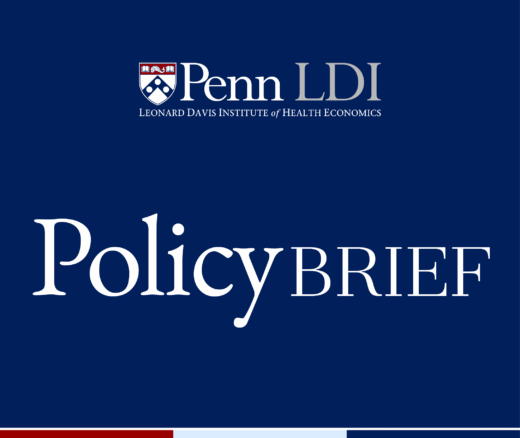
Reforming Long-Term Care Policy
Lessons from the Past, Imperatives for the Future
Improving Care for Older Adults
News
A new National Academies of Sciences, Engineering, and Medicine consensus study calls for a sweeping reorganization of the U.S. nursing home industry and its regulation. The 605-page report cites decades of inadequate resident care along with management shortcomings that led to the catastrophic levels of mortality experienced in nursing homes during the pandemic.
The report points out that despite nursing home residents making up less than half of one percent of the U.S. population, as of October 2021, they accounted for approximately 19 percent of all COVID-19 deaths. It says: “the pandemic also highlighted the pervasive ageism evident in undervaluing the lives of older adults.” It emphasizes that “immediate action to initiate fundamental change is necessary” to change the way nursing homes operate in order to improve care and better prepare those institutions for future national health emergencies.
Entitled “The National Imperative to Improve Nursing Home Quality,” the report concludes that the way in which the United States finances, delivers, and regulates care for nearly 1.3 million patients residing in more than 15,000 nursing homes “is ineffective, inefficient, fragmented, and unsustainable.”

The study was conducted by a special 12-member ad hoc NASEM group of top experts — the NASEM Committee on the Quality of Care in Nursing Homes — including LDI Executive Director Rachel M. Werner, MD, PhD, and LDI Senior Fellow Mary Ersek, PhD, RN. The committee’s work was sponsored by the John A Hartford Foundation, Commonwealth Fund, Sephardic Foundation, Jewish Healthcare Foundation, and Fan Fox & Leslie R. Samuels Foundation.
“It’s been 35 years since the last National Academies’ analysis and the resulting Congressional action aimed at addressing inadequate care in nursing homes,” said Werner, a leading expert in the field of nursing home quality, payment, and financing. “Despite those efforts, significant shortfalls in nursing home care remained, leaving the untenable situation that has been magnified during the pandemic. The current report provides a blueprint on how to meaningfully improve nursing home care, making it safer, more person-centered, and equitable.”

Convened in November 2020, the ad hoc committee was charged with “examining how our nation delivers, regulates, finances and measures the quality of nursing home care.” Sixteen months later, the committee envisions dramatic changes across virtually all areas of nursing home operations and quality control, including even architectural standards, greatly expanded medical services, and a complete overhaul of woefully ineffective workforce policies and practices.
“Too many nursing home workers, surveyors, and others do not receive adequate and appropriate support needed to fulfill their critical responsibilities,” the report points out. It finds that “the nursing home sector has suffered for many decades from both underinvestment as well as a lack of accountability for how resources are allocated. One result of this underinvestment is to have made working in a nursing home an undesirable form of employment.”
Along with the financial, political, and logistical issues the committee vision entails, there is also the challenge of insufficient scientific information needed to inform many reorganization decisions. The report cites the “significant lack of data in many key areas, with many of the available data sources and studies quite dated; in many instances, the most recent studies on a specific topic had been conducted years or even decades earlier.”
A 46-page chapter of the report provides comprehensive detail on seven goals of a unified plan for changes in nursing home operation, quality control and regulation. They are:
Goal 1: Deliver comprehensive, person-centered, equitable care that ensures the health, quality of life, and safety of nursing home residents; promotes resident autonomy; and manages risks.
Goal 2: Ensure a well-prepared, empowered, and appropriately compensated workforce.
Goal 3: Increase transparency and accountability of finances, operations, and ownership.
Goal 4: Create a more rational and robust financing system.
Goal 5: Design a more effective and responsive system of quality assurance.
Goal 6: Expand and enhance quality measurement and continuous quality improvement.
Goal 7: Adopt health information technology in all nursing homes.
The full implementation and funding of the recommended changes would require actions across numerous stakeholders and government agencies, including in both state legislatures and the U.S. Congress.
The committee concludes by saying the failure to adopt this unified plan “will guarantee the continuation of many shortcomings that prevent the delivery of high-quality care in all nursing homes… implementing the committee’s integrated set of recommendations will move the nation closer to making high-quality, person-centered, and equitable care a reality.”


Lessons from the Past, Imperatives for the Future

Technology Helps Older Adults Stay at Home—But May Delay Necessary Transitions to Higher Levels of Care

Her Transitional Care Model Shows How Nurse-Led Care Can Keep Older Adults Out of the Hospital and Change Care Worldwide

Direct-to-Consumer Alzheimer’s Tests Risk False Positives, Privacy Breaches, and Discrimination, LDI Fellow Warns, While Lacking Strong Accuracy and Much More

New Therapies Inspire Hope, Even as Access and Treatment Risks Continue to Challenge Patients and Providers

Penn LDI Senior Fellow Yong Chen Is an MPI in the 10-Institution NIA Undertaking